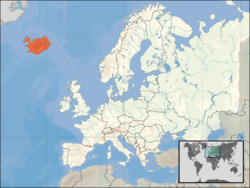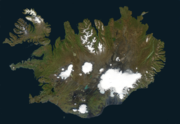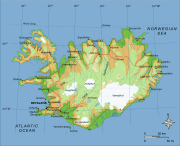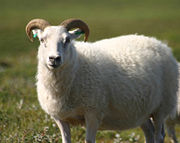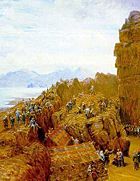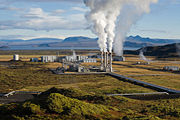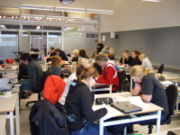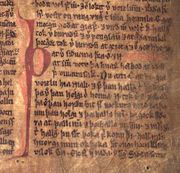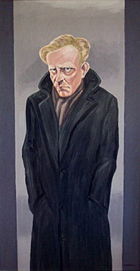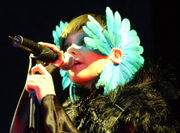Iceland
2008/9 Schools Wikipedia Selection. Related subjects: Europe; European Countries
| Lýðveldið Ísland Republic of Iceland
|
||||||
|---|---|---|---|---|---|---|
|
||||||
| Anthem: Lofsöngur |
||||||
|
Location of Iceland (red) in Europe (white)
|
||||||
| Capital (and largest city) |
Reykjavík |
|||||
| Official languages | Icelandic | |||||
| Demonym | Icelander | |||||
| Government | Parliamentary republic | |||||
| - | President | Ólafur Ragnar Grímsson | ||||
| - | Prime Minister | Geir Haarde | ||||
| - | Althing President | Sturla Böðvarsson | ||||
| Independence | from Denmark | |||||
| - | Home rule | 1 February 1904 | ||||
| - | Sovereignty | 1 December 1918 | ||||
| - | Republic | 17 June 1944 | ||||
| Area | ||||||
| - | Total | 103,000 km² ( 107th) 39,770 sq mi |
||||
| - | Water (%) | 2.7 | ||||
| Population | ||||||
| - | April 2008 estimate | 316,2521 ( 172nd) | ||||
| - | December 1980 census | 229,187 | ||||
| - | Density | 3,1/km² ( 233th) 7.5/sq mi |
||||
| GDP ( PPP) | 2006 estimate | |||||
| - | Total | $12.172 billion ( 132nd) | ||||
| - | Per capita | $40,277 (2005) ( 5th) | ||||
| GDP (nominal) | 2006 estimate | |||||
| - | Total | $16.579 billion ( 93rd) | ||||
| - | Per capita | $62,976 ( 4th) | ||||
| HDI (2007) | ▲ 0.968 (high) ( 1st) | |||||
| Currency | Icelandic króna ( ISK) |
|||||
| Time zone | GMT ( UTC+0) | |||||
| Internet TLD | .is | |||||
| Calling code | +354 | |||||
| 1 | " Statistics Iceland:Key figures". www.statice.is ( 1 October 2007). | |||||
Iceland, officially the Republic of Iceland ( Icelandic: Ísland or Lýðveldið Ísland ( names of Iceland); IPA: [ˈliðvɛltɪð ˈistlant]) is a country in northern Europe, comprising the island of Iceland and its outlying islets in the North Atlantic Ocean between the rest of Europe and Greenland. It is the least populous of the Nordic countries and the second smallest; it has a population of about 316,000 ( April 1, 2008 estimate) and a total area of 103,000 km². Its capital and largest city is Reykjavík.
Located on the Mid-Atlantic Ridge, Iceland is volcanically and geologically active on a large scale; this defines the landscape in various ways. The interior mainly consists of a plateau characterized by sand fields, mountains and glaciers, while many big glacial rivers flow to the sea through the lowlands. Warmed by the Gulf Stream, Iceland has a temperate climate relative to its latitude and provides a habitable environment and nature.
The settlement of Iceland began in 874 when, according to Landnámabók, the Norwegian chieftain Ingólfur Arnarson became the first permanent Norwegian settler on the island. Others had visited the island earlier and stayed over winter. Over the next centuries, people of Nordic and Gaelic origin settled in Iceland. Until the twentieth century, the Icelandic population relied on fisheries and agriculture, and was from 1262 to 1918 a part of the Norwegian and later the Danish monarchies. In the twentieth century, Iceland's economy and welfare system developed quickly. In recent decades, Iceland has seen economic reforms, free trade in the European Economic Area, and diversification from fishing to new economic fields in services, finance, and various industries.
Today, Iceland has some of the world's highest levels of economic freedoms as well as civil freedoms. As of 2007, Iceland is the most developed country in the world with fellow Nordic country Norway according to the Human Development Index and one of the most egalitarian, according to the calculation provided by the Gini coefficient. It is also the fourth most productive country per capita. Icelanders have a rich culture and heritage, such as cuisine and poetry (thus the country itself has many names coined by poets). Iceland is a member of the UN, NATO, EFTA, EEA and OECD, but not of the European Union. The country is a candidate for a non-permanent seat at the UN Security Council.
Geography
Topography
Iceland is located in the North Atlantic Ocean just south of the Arctic Circle, which passes through the small island of Grímsey off Iceland's northern coast, but not through mainland Iceland. Unlike neighbouring Greenland, Iceland is considered to be a part of Europe, not of North America, though geologically the island belongs to both continents. Because of cultural, economic and linguistic similarities, Iceland in many contexts is also included in Scandinavia. The closest bodies of land are Greenland (287 km) and the Faroe Islands (420 km). The closest distance to the mainland of Europe is 970 km (to Norway).
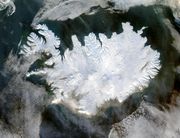
Iceland is the world's 18th largest island, and Europe's second largest island following Great Britain. The country is 103,000 km² (39,768.5 sq mi) in size, of which 62.7% is wasteland. Lakes and glaciers cover 14.3%; only 23% is vegetated. The largest lakes are Þórisvatn ( Reservoir): 83–88 km² (32–34 sq mi) and Þingvallavatn: 82 km² (32 sq mi); other important lakes include Lögurinn and Mývatn. Öskjuvatn is the deepest lake at 220 m (722 ft).
Many fjords punctuate its extensive coastline, which is also where most settlements are situated because the island's interior, the Highlands of Iceland, is a cold and uninhabitable combination of sand and mountains. The major towns are the capital Reykjavík, Kópavogur, Hafnarfjörður, Reykjanesbær, where the international airport is located, and Akureyri. The island of Grímsey on the Arctic Circle contains the northernmost habitation of Iceland.
Iceland has four national parks: Jökulsárgljúfur National Park, Skaftafell National Park, Snæfellsjökull National Park, and Þingvellir National Park.
Geological activity
A geologically young land, Iceland is located on both the Iceland hotspot and the Mid-Atlantic Ridge, which runs right through it. This combined location means that geologically the island is extremely active, having many volcanoes, notably Hekla, Eldgjá, and Eldfell. The volcanic eruption of Laki in 1783–1784 caused a famine that killed nearly a quarter of the island's population; the eruption caused dust clouds and haze to appear over most of Europe and parts of Asia and Africa for several months after the eruption.
There are also many geysers in Iceland, including Geysir, from which the English word is derived. With this widespread availability of geothermal power, and because many rivers and waterfalls are harnessed for hydroelectricity, most residents have hot water and home heat cheaply. The island itself is composed primarily of basalt, a low-silica lava associated with effusive volcanism like Hawaii. But Iceland has various kinds of volcanoes, many of which produce more evolved lavas such as rhyolite and andesite.
Iceland controls Surtsey, one of the youngest islands in the world. It rose above the ocean in a series of volcanic eruptions between November 8, 1963 and June 5, 1968.
Climate
The climate of Iceland's coast is subpolar oceanic. The warm North Atlantic Current ensures generally higher annual temperatures than in most places of similar latitude in the world. The winters are mild and windy while the summers are damp and cool. Regions in the world with similar climate include the Aleutian Islands, Alaska Peninsula and Tierra del Fuego although these regions are closer to the equator. Despite its proximity to the Arctic, the island's coasts remain ice-free through the winter. Ice incursions are rare, the last having occurred on the north coast in 1969.
There are some variations in the climate between different parts of the island. Very generally speaking, the south coast is warmer, wetter and windier than the north. Low-lying inland areas in the north are the most arid. Snowfall in winter is more common in the north than the south. The Central Highlands are the coldest part of the country.
The highest air temperature recorded was 30.5 °C (86.9 °F) on 22 June 1939 at Teigarhorn on the south-eastern coast. The lowest was -38 °C (-36.4 °F) on 22 January 1918 at Grímsstaðir and Möðrudalur in the northeast hinterland. The temperature records for Reykjavík are 24.8 °C (76.6 °F) on 11 August 2004, and -24.5 °C (-12.1 °F) on 21 January 1918.
| Location | Jan | Feb | Mar | Apr | May | Jun | Jul | Aug | Sep | Oct | Nov | Dec | All | |
|---|---|---|---|---|---|---|---|---|---|---|---|---|---|---|
| Reykjavík | 1.9 | 2.8 | 3.2 | 5.7 | 9.4 | 11.7 | 13.3 | 13.0 | 10.1 | 6.8 | 3.4 | 2.2 | High | 7.0 |
| -3.0 | -2.1 | -2.0 | 0.4 | 3.6 | 6.7 | 8.3 | 7.9 | 5.0 | 2.2 | -1.3 | -2.8 | Low | 1.9 | |
| Akureyri | 0.9 | 1.7 | 2.1 | 5.4 | 9.5 | 13.2 | 14.5 | 13.9 | 9.9 | 5.9 | 2.6 | 1.3 | High | 6.7 |
| -5.5 | -4.7 | -4.2 | -1.5 | 2.3 | 6.0 | 7.5 | 7.1 | 3.5 | 0.4 | -3.5 | -5.1 | Low | 0.2 |
Flora and fauna
The short time since the last ice age, 10,000 years ago, has mostly prevented plants and animals from migrating to the island or evolving locally. There are around 1,300 known species of insects in Iceland, which is rather low compared with other countries (about 925,000 are known in the world). The only native land mammal when humans arrived was the arctic fox, which came to the island at the end of the ice age, walking over the frozen sea. There are no native reptiles or amphibians on the island.
Phytogeographically, Iceland belongs to the Arctic province of the Circumboreal Region within the Boreal Kingdom. According to the WWF, the territory of Iceland belongs to the ecoregion of Iceland boreal birch forests and alpine tundra. Approximately three-quarters of the island are barren of vegetation; plant life consists mainly of grassland which is regularly grazed by livestock. The only tree native to Iceland is the northern birch Betula pubescens, which formerly formed forest over much of southern Iceland. Permanent human settlement greatly disturbed the isolated ecosystem of thin, volcanic soils and limited species diversity. The forests were heavily exploited over the centuries for firewood and timber. Deforestation caused a loss of critical topsoil due to erosion, greatly reducing the ability of birches to grow back. Today, only a few small birch stands exist in isolated reserves. The planting of new forests has increased the number of trees, but does not compare to the original forests. Some of the planted forests include new foreign species.
The animals of Iceland include the Icelandic sheep, cattle, chicken, goat and the sturdy Icelandic horse. Many varieties of fish live in the ocean waters surrounding Iceland, and the fishing industry is a main contributor to Iceland’s economy, accounting for more than half of its total exports. Wild mammals include the arctic fox, mink, mice, rats, rabbits and reindeer. Before and around the 1900s polar bears occasionally visited the island, traveling on icebergs from Greenland. Birds, especially sea birds, are a very important part of Iceland's animal life. Puffins, skuas, and kittiwakes nest on its sea cliffs. Though Iceland no longer has a commercial whaling fleet (as of August, 2007) it still allows scientific whale hunts, which are not supported by the Scientific Committee of the International Whaling Commission (IWC).
History
Age of settlement
The first people thought to have inhabited Iceland were Irish monks or hermits who came in the eighth century, but left with the arrival of Norsemen, who systematically settled Iceland in the period circa AD 870-930. The first known permanent Norse settler was Ingólfur Arnarson, who built his homestead in Reykjavík in 874. Ingólfur was followed by many other emigrant settlers, largely Norsemen and their Irish slaves. By 930, most arable land had been claimed and the Althing, a legislative and judiciary parliament, was founded as the political hub of the Icelandic Commonwealth. Christianity was adopted in 1000. The Commonwealth lasted until 1262, when the political system devised by the original settlers proved unable to cope with the increasing power of Icelandic chieftains.
Middle Ages to the Early Modern Era
The internal struggles and civil strife of the Sturlung Era led to the signing of the Old Covenant, which brought Iceland under the Norwegian crown. Possession of Iceland passed to Denmark-Norway in the late 14th century when the kingdoms of Norway and Denmark were united in the Kalmar Union. In the ensuing centuries, Iceland became one of the poorest countries in Europe. Infertile soil, volcanic eruptions, and an unforgiving climate made for harsh life in a society whose subsistence depended almost entirely on agriculture. The Black Death swept Iceland in 1402–1404 and 1494–1495, each time killing approximately half the population.
Around the middle of the 16th century, King Christian III of Denmark began to impose Lutheranism on all his subjects. The last Catholic bishop in Iceland was beheaded in 1550, and the country subsequently became fully Lutheran. Lutheranism has since remained the dominant religion. In the 1600s and 1700s, Denmark imposed harsh trade restrictions on Iceland, while pirates from England, Spain and Algeria raided its coasts. A great smallpox epidemic in the 18th century killed around one-third of the population. In 1783 the Laki volcano erupted, with devastating effects. The years following the eruption, known as the Mist Hardships (Icelandic: Móðuharðindin), saw the death of over half of all livestock in the country, with ensuing famine in which around a quarter of the population died.
Independence and recent history
In 1814, following the Napoleonic Wars, Denmark-Norway was broken up into two separate kingdoms via the Treaty of Kiel. Iceland remained a Danish dependency. A new independence movement arose under the leadership of Jón Sigurðsson, inspired by the romantic and nationalist ideologies of mainland Europe. In 1874, Denmark granted Iceland home rule, which was expanded in 1904. The Act of Union, an agreement with Denmark signed on December 1, 1918, recognized Iceland as a fully sovereign state under the Danish king. During the last quarter of the 19th century many Icelanders emigrated to North America, largely Canada, in search of better living conditions.
Iceland during World War II joined Denmark in asserting neutrality. After the German occupation of Denmark on April 9, 1940, Iceland's parliament declared that the Icelandic government should assume the Danish king's authority and take control over foreign affairs and other matters previously handled by Denmark on behalf of Iceland. A month later, British military forces occupied Iceland, violating Icelandic neutrality. In 1941, responsibility for the occupation was taken over by the United States Army. Allied occupation of Iceland lasted throughout the war.
On December 31, 1943 the Act of Union agreement expired after 25 years. Beginning on May 20, 1944, Icelanders voted in a four-day plebiscite on whether to terminate the union with Denmark and establish a republic. The vote was 97% in favor of ending the union and 95% in favour of the new republican constitution. Iceland formally became an independent republic on June 17, 1944, with Sveinn Björnsson as the first President. The Allied occupation force left in 1946. Iceland became a member of NATO on March 30, 1949, amid domestic controversy and riots and on May 5, 1951, a defense agreement was signed with the United States. American troops returned to Iceland and remained throughout the Cold War until autumn 2006.
The immediate post-war period was followed by substantial economic growth, driven by industrialization of the fishing industry and Marshall aid and Keynesian government management of the economies of Europe, all of which promoted trade. The 1970s were marked by the Cod Wars – several disputes with the United Kingdom over Iceland's extension of its fishing limits. The economy was greatly diversified and liberalized following Iceland's joining of the European Economic Area in 1992.
Government
Iceland is a representative democracy and a parliamentary republic. The modern parliament, called "Alþingi" (English: Althing), was founded in 1845 as an advisory body to the Danish king. It was widely seen as a reestablishment of the assembly founded in 930 in the Commonwealth period and suspended in 1799. It currently has sixty-three members, each of whom is elected every four years.
The president of Iceland is a largely ceremonial office that serves as a diplomat, figurehead and head of state, but who can also block a law voted by the parliament and put it to a national referendum. The current president is Ólafur Ragnar Grímsson. The head of government is the prime minister, who, together with the cabinet, takes care of the executive part of government. The cabinet is appointed by the president after general elections to Althing; however, this process is usually conducted by the leaders of the political parties, who decide among themselves after discussions which parties can form the cabinet and how its seats are to be distributed, under the condition that it has a majority support in Althing. Only when the party leaders are unable to reach a conclusion by themselves in reasonable time does the president exercise this power and appoint the cabinet himself. This has not happened since the republic was founded in 1944, but in 1942 the regent of the country ( Sveinn Björnsson, who had been installed in that position by the Althing in 1941) did appoint a non-parliamentary government. The regent had, for all practical purposes, the position of a president, and Sveinn in fact became the country's first president in 1944.
The governments of Iceland have almost always been coalitions with two or more parties involved, due to the fact that no single political party has received a majority of seats in Althing in the republic period. The extent of the political powers possessed by the office of the president is disputed by legal scholars in Iceland; several provisions of the constitution appear to give the president some important powers but other provisions and traditions suggest differently. In 1980, Icelanders elected Vigdís Finnbogadóttir as president, the world's first directly elected female head of state. She retired from office in 1996.
Elections for the office of town councils, parliament and presidency are each held every four years. The next elections are scheduled for 2010, 2011 and 2008, respectively.
Subdivisions
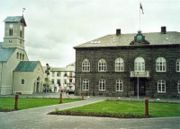
Iceland is divided into regions, constituencies, counties, and municipalities. There are eight regions which are primarily used for statistical purposes; the district court jurisdictions also use an older version of this division. Until 2003, the constituencies for the parliament elections were the same as the regions, but by an amendment to the constitution, they were changed to the current six constituencies:
-
- Reykjavík North and Reykjavík South (city regions);
- Southwest (four geographically separate suburban areas around Reykjavík);
- Northwest and Northeast (north half of Iceland, split); and,
- South (south half of Iceland, excluding Reykjavík and suburbs).
The redistricting change was made in order to balance the weight of different districts of the country, since a vote cast in the sparsely populated areas around the country would count much more than a vote cast in the Reykjavík city area. The imbalance between districts has been reduced by the new system, but still exists.
Iceland's twenty-three counties are, for the most part, historical divisions. Currently, Iceland is split up among twenty-six magistrates ( sýslumenn) that represent government in various capacities. Among their duties are tax collection, administering bankruptcy declarations, and performing civil marriages. After a police re-organization in 2007, which combined police forces in multiple counties, about half of them are in charge of police forces.
There are seventy-nine municipalities in Iceland which govern local matters like schools, transportation and zoning. These are the actual second-level subdivisions of Iceland, as the constituencies have no relevance except in elections and for statistical purposes. Reykjavík is by far the most populous municipality, about four times more populous than Kópavogur, the second one.
Politics
Iceland has a left-right multi-party system. The biggest party is the right wing Independence Party (’’Sjálfstæðisflokkurinn’’), while the second largest one is the social democratic Alliance (‘’Samfylkingin’’). Following the May 2007 parliamentary elections, these two formed a coalition, enjoying a strong majority in Althing, with 43 out of 63 members supporting it.
Other political parties that have a seat in Althing are the centrist Progressive Party (‘’Framsóknarflokkurinn’’), which had been in government with the Independence Party for 12 years before the 2007 election, the Left-Green Movement (‘’Vinstrihreyfingin - grænt framboð’’), founded in 1999, and the Centre-right Liberal Party. Many other parties exist on the municipal level, most of which only run locally in a single municipality.
Foreign relations
Iceland maintains diplomatic and commercial relations with practically all nations, but its ties with the Nordic countries, Germany, the US, and the other NATO nations are particularly close. Icelanders remain especially proud of the role Iceland played in hosting the historic 1986 Reagan-Gorbachev summit in Reykjavík, which set the stage for the end of the Cold War. Iceland's principal historical international disputes involved disagreements over fishing rights. Conflict with Britain led to a series of so-called Cod Wars in 1952-1956 as a result of the extension of Iceland's fishing zone from 3 to 4 nautical miles (6 to 7 km), 1958-1961 following a further extension to 12 nautical miles (22 km), 1972-1973 with another extension to 50 nautical miles (93 km) and in 1975-1976: another extension to 200 nautical miles (370 km).
Iceland has no standing army. The U.S. Air Force maintained four to six Interceptors at the Keflavík base, until 30 September 2006 when they were withdrawn. Iceland supported the 2003 invasion of Iraq despite much controversy and condemnation in Iceland, deploying a Coast Guard EOD team to Iraq which was replaced later by members of the Icelandic Crisis Response Unit. Iceland has also participated in the ongoing conflict in Afghanistan and the 1999 bombing of Yugoslavia.
Demographics
| Total | 313,376 |
| Iceland | 291,942 |
| Poland | 8,488 |
| Lithuania | 1,332 |
| Germany | 984 |
| Denmark | 966 |
| Portugal | 890 |
| Philippines | 743 |
| Ex-Yugoslavia | 651 |
| United States | 598 |
| Thailand | 545 |
| Latvia | 431 |
| United Kingdom | 420 |
| Sweden | 407 |
| China (PRC) | 379 |
| Ex- Czechoslovakia | 365 |
| Norway | 301 |
| others | 3,934 |
| total (without Icelanders) | 21,434 |
The original population of Iceland was of Nordic and Celtic origin. This is evident from literary evidence dating from the settlement period as well as from later scientific studies such as blood type and genetic analyses. One such genetics study has indicated that the majority of the male settlers were of Nordic origin while the majority of the women were of Celtic origin.
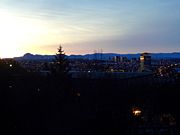
Iceland has extensive genealogical records dating back to the late 1600s and fragmentary records extending back to the Age of Settlement. The biopharmaceutical company deCODE Genetics has funded the creation of a genealogy database which attempts to cover all of Iceland's known inhabitants. It sees the database, called Íslendingabók, as a valuable tool for conducting research on genetic diseases, given the relative isolation of Iceland's population.
The population of the island is believed to have varied from 40,000 to 60,000 in the period from initial settlement until the mid-19th century. During that time, cold winters, ashfall from volcanic eruptions, and bubonic plagues adversely affected the population several times. The first census was carried out in 1703 and revealed that the population was then 50,358. After the destructive volcanic eruptions of the Laki volcano during 1783–1784 the population reached a low of about 40,000. Improving living conditions have triggered a rapid increase in population since the mid-19th century - from about 60,000 in 1850 to 316,000 in 2008.
In December 2007, 33,678 people (13.5% of the total population) who were living in Iceland had been born abroad, including children of Icelandic parents living abroad. 19,000 people (6% of the population) held foreign citizenship. Poles make up the far largest minority nationality (see table on the right for more details), and still form the bulk of the foreign workforce. About 9,000 Poles now live in Iceland, 1,500 of them in Reyðarfjörður where they make up 75 percent of the workforce who are building the Fjarðarál aluminium plant. The recent surge in immigration has been credited to a labor shortage because of the booming economy while restrictions on the movement of people from the Eastern European countries that joined the EU/ EEA in 2004 have been lifted. Large-scale construction projects in the east of Iceland (see Kárahnjúkar Hydropower Project) have also brought in many people whose stay is expected to be temporary.
The south-west corner of Iceland is the most densely populated region. It is also the location of the capital Reykjavík, the northernmost capital in the world. The largest towns outside the greater Reykjavík area are Akureyri and Reykjanesbær, although the latter is relatively close to the capital.
10 most populous towns in Iceland
List of ten most populous towns in Iceland. The population census is April 1, 2008 (estimate).
- Reykjavík - 118,861
- Kópavogur - 30,000
- Hafnarfjörður - 25,107
- Akureyri - 17,304
- Reykjanesbær - 13,686
- Garðabær - 10.139
- Mosfellsbær - 8,317
- Árborg - 7,693
- Akranes - 6,419
- Fjarðabyggð - 5,000
Language
Iceland's official written and spoken language is Icelandic, a North Germanic language descended from Old Norse. It has changed less from Old Norse than the other Nordic languages, has preserved more verb and noun inflection, and has to a considerable extent developed new vocabulary based on native roots rather than borrowings from English. It is the only living language to retain the runic letter Þ. The closest living language to Icelandic is Faroese. In education, the use of Icelandic Sign Language for Iceland's deaf community is regulated by the National Curriculum Guide.
English is widely spoken as a secondary language, and many Icelanders speak it at an almost native level. Danish is also widely understood. Studying both these languages is a mandatory part of the compulsory school curriculum. Other commonly spoken languages are German, Norwegian and Swedish. Danish is mostly spoken in a way largely comprehensible to Swedes and Norwegians – it is often referred to as "Scandinavian" in Iceland.
In addition to Icelandic, many immigrants speak their respective native languages.
Religion
Icelanders enjoy freedom of religion under the constitution, though there is no separation of church and state. The National Church of Iceland, a Lutheran body, is the state church. The national registry keeps account of the religious affiliation of every Icelandic citizen. In 2005, Icelanders divided into religious groups as follows:
- 82.1% members of the National Church of Iceland.
- 4.7% members of the Free Lutheran Churches of Reykjavík and Hafnarfjörður.
- 2.6% not members of any religious group.
- 2.4% members of the Roman Catholic Church, which has a Diocese of Reykjavík (see also Bishop of Reykjavik (Catholic))
- 5.5% members of unregistered religious organisations or with no specified religious affiliation
The remaining 2.7% is mostly divided between around 20–25 other Christian denominations and sects, and less than 1% are in non-Christian religious organisations. The largest non-Christian denomination is Íslenska Ásatrúarfélagið, a neopagan group.
Religious attendance is relatively low, as in other Nordic countries. The above statistics represent administrative membership of religious organizations and not the actual belief demographics of the population of Iceland.
Economy and infrastructure
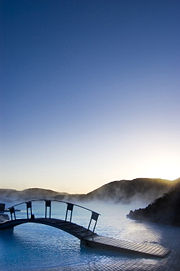
Iceland is the fourth most productive country in the world by nominal gross domestic product per capita (54,858 USD), and the fifth most productive by GDP at purchasing power parity (40,112 USD). Except for its abundant hydro-electric and geothermal power, Iceland lacks natural resources; historically its economy depended heavily on the fishing industry, which still provides almost 40% of export earnings and employs 8% of the work force. The economy is vulnerable to declining fish stocks and drops in world prices for its main material exports: fish and fish products, aluminium, and ferrosilicon. Although the Icelandic economy still relies heavily on fishing, its importance is diminishing as the travel industry and other service, technology and various other industries grow. Economic growth slowed from 2000 to 2002, but the economy expanded by 4.3% in 2003 and 6.2% in 2004. The unemployment rate of ~1.0% (2007 est.) is among the lowest in the European Economic Area.
Although Iceland is a very developed country, it is still one of the most newly-industrialized ones in Europe. Until the 20th century, it was probably the poorest country in Western Europe. The fast economic growth that it has experienced in the last decades is only recently allowing for upgrading of infrastructure such as transportation. The government coalition plans to continue its generally neo-liberal policies of reducing the budget and current account deficits, limiting foreign borrowing, containing inflation, revising agricultural and fishing policies, diversifying the economy, and privatising state-owned industries. The government remains opposed to EU membership, primarily because of Icelanders' concern about losing control over their fishing resources.
Iceland's economy has been diversifying into manufacturing and service industries in the last decade, including software production, biotechnology, and financial services. The tourism sector is expanding, with the recent trends in ecotourism and whale-watching. Iceland's agriculture industry consists mainly of potatoes, turnips, green vegetables (in greenhouses), mutton and dairy products. The financial centre is Borgartún in Reykjavik, hosting a large number of companies and three investment banks. Iceland's stock market, the Iceland Stock Exchange (ISE), was established in 1985.
The primary currency of Iceland is the Icelandic Króna (ISK). Iceland's then foreign minister Valgerður Sverrisdóttir said in an interview on 15 January 2007 that she seriously wished to look into whether Iceland can join the Euro without being a member of the EU. She believes it is difficult to maintain an independent currency in a small economy on the open European market. An extensive poll, released on 11 September 2007, by Capacent Gallup showed that 53% of respondents were in favour of adopting the euro, 37% opposed and 10% undecided.
Iceland ranked 5th in the Index of Economic Freedom 2006 and 14th in 2008. Iceland has a flat tax system. The main personal income tax rate is a flat 22.75 percent and combined with municipal taxes the total tax rate is not more than 35.72%, and there are many deductions. The corporate tax rate is a flat 18 percent, one of the lowest in the world. Other taxes include a value-added tax and a net wealth tax. Employment regulations are relatively flexible. Property rights are strong and Iceland is one of the few countries where they are applied to fishery management. Taxpayers pay various subsidies to each other, similar to European countries with welfare state, but the spending is less than in most European countries. Despite low tax rates, overall taxation and consumption is still much higher than countries such as Ireland. According to OECD, agricultural support is the highest among OECD countries and an impediment to structural change. Also, health care and education spending have relatively poor return by OECD measures. OECD Economic survey of Iceland 2008 highlights Iceland's challenges in currency and macroeconomic policy.
Iceland is the most developed society in the world, ranked first on the United Nations’ Human Development Index. Icelanders are the second longest-living nation with a life expectancy at birth of 81.8 years. Iceland is one of the most egalitarian countries in the world, according to the calculation provided by the Gini coefficient.
Transportation
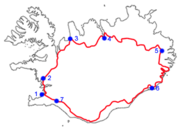
The social structure of Iceland is very dependent upon the personal automobile. Icelanders have one of the highest levels of cars per capita: on average one car per inhabitant older than 17 years. Most Icelanders travel by car to work, school or other activities.
The main mode of transport in Iceland is road. Iceland has 13,034 km of administered roads, of which 4,617 km are paved and 8,338 km are not. Until the second half of the 20th century, Iceland could only afford to pave roads near the biggest towns. Today, roads are being improved throughout the country and freeways are being built in and around Reykjavík. Iceland currently has no railways.
Route 1 or the Ring Road (Icelandic: Þjóðvegur 1 or Hringvegur) is a main road in Iceland that runs around the island and connects all inhabited parts (the interior of the island is uninhabited). The road is 1339 km long (840 miles). It has one lane in each direction, except near larger towns and cities and in the Hvalfjörður Tunnel where it has more lanes. Most smaller bridges on it are single lane and made of wood and/or steel. Most of the road's length is paved with asphalt, but some stretches in the east still have a gravel surface.
The main hub for international transportation is Keflavík International Airport, which serves Reykjavík and the country in general. It is 48km (30mi) to the west of Reykjavík. Domestic and regional flights to Greenland and the Faroe Islands operate out of Reykjavík Airport, which lies in the city centre. There are 86 airport runways in Iceland; most of them are unpaved and located in rural areas.
Energy
Renewable energy provides over 70% of the nation's primary energy. Over 99% of the country's electricity is produced from hydropower and geothermal energy, and the country expects to be energy-independent by 2050. Iceland's largest geothermal power plant is located in Nesjavellir, while the Kárahnjúkar dam will be the country's largest hydroelectric power plant.
Yet, Icelanders still emit 10.0 tonnes of CO2 equivalent of greenhouse gasses per capita, higher than France or Spain. This is due to the wide use of personal transport. Iceland is the only country that has filling stations dispensing hydrogen fuel for cars powered by fuel cells. It is also one of only a few countries currently capable of producing hydrogen in adequate quantities at reasonable cost, because of Iceland's plentiful geothermal energy.
Education, science, and technology
The Ministry of Education, Science and Culture is responsible for the policies and methods that schools must use, and they issue the National Curriculum Guidelines. However, the playschools and the primary and lower secondary schools are funded and administered by the municipalities.
Nursery school or leikskóli, is non-compulsory education for children younger than six years, and is the first step in the education system. The current legislation concerning playschools was passed in 1994. They are also responsible for ensuring that the curriculum is suitable so as to make the transition into compulsory education as easy as possible.
Compulsory education, or grunnskóli, comprises primary and lower secondary education, which often is conducted at the same institution. Education is mandatory by law for children aged from 6 to 16 years. The school year lasts nine months, and begins between 21 August and 1 September, ending between 31 May and 10 June. The minimum number of school days is 170, but after a new teachers’ wage contract, this will increase to 180. Lessons take place five days a week. The Programme for International Student Assessment, coordinated by the OECD, currently ranks the Icelandic secondary education as the 27th in the world, significantly below the OECD average.
Upper secondary education or framhaldsskóli follows lower secondary education. These schools are also known as gymnasia in English. It is not compulsory, but everyone who has had a compulsory education has the right to upper secondary education. This stage of education is governed by the Upper Secondary School Act of 1996. All schools in Iceland are mixed sex schools.
Iceland is a very technologically advanced society. By 1999, 82.3% of Icelanders had access to a computer. Iceland also had 1,007 mobile phone subscriptions per 1,000 people in 2006, the 16th highest in the world.
Iceland is home to European Mars Analog Research Station.
Culture
Icelandic culture has its roots in Norse traditions. Icelandic literature is popular, in particular the sagas and eddas which were written around the time of the island’s settlement. Icelanders place relatively great importance on independence and self-sufficiency; in a European Commission public opinion analysis over 85% of Icelanders found independence to be "very important" contrasted with the EU25 average of 53%, and 47% for the Norwegians, and 49% for the Danes.
Some traditional beliefs remain today; for example, some Icelanders either believe in elves or are unwilling to rule out their existence. Iceland ranks first on the Human Development Index, and was recently ranked the fourth happiest country in the world.
Iceland is liberal in terms of lesbian, gay bisexual and transgendered ( LGBT) matters. In 1996, Parliament passed legislation to create registered partnerships for same-sex couples, covering nearly all the rights and benefits of marriage. In 2006, by unanimous vote of Parliament, further legislation was passed, granting same-sex couples the same rights as different-sex couples in adoption, parenting and assisted insemination treatment.
Literature and the arts
Iceland's best-known classical works of literature are the Icelanders' sagas, prose epics set in Iceland's age of settlement. The most famous of these include Njáls saga, about an epic blood feud, and Grœnlendinga saga and Eiríks saga, describing the discovery and settlement of Greenland and Vinland (modern Newfoundland). Egils saga, Laxdæla saga, Grettis saga, Gísla saga and Gunnlaugs saga ormstungu are also notable and popular Icelanders' sagas.
A translation of the Bible was published in the 16th century. Important compositions since the 15th to the 19th century include sacred verse, most famously the Passíusálmar of Hallgrímur Pétursson, and rímur, rhymed epic poems with alliterative verse that consist in two to four verses per stanza, popular until the end of the 19th century. In recent times, Iceland has produced many great writers, the best-known of which is arguably Halldór Laxness who received the Nobel Prize for Literature in 1955. Steinn Steinarr was an influential modernist poet.
The distinctive rendition of the Icelandic landscape by its painters can be linked to nationalism and the movement to home rule and independence, which was very active in this period.
Contemporary Icelandic painting is typically traced to the work of Þórarinn Þorláksson, who, following formal training in art in the 1890s in Copenhagen, returned to Iceland to paint and exhibit works from 1900 to his death in 1924, almost exclusively portraying the Icelandic landscape. Several other Icelandic men and women artists learned in Denmark Academy at that time, including Ásgrímur Jónsson, who together with Þórarinn created a distinctive portrayal of Iceland's landscape in a romantic naturalistic style. Other landscape artists quickly followed in the footsteps of Þórarinn and Ásgrímur. These included Jóhannes Kjarval and Júlíana Sveinsdóttir. Kjarval in particular is noted for the distinct techniques in the application of paint that he developed in a concerted effort to render the characteristic volcanic rock that dominates the Icelandic environment. Einar Hákonarson is an expressionistic and figurative painter who brought the figure back into Icelandic painting.
Icelandic architecture draws from Scandinavian influences. The scarcity of native trees resulted in traditional houses being covered by grass and turf.
Music
Icelandic music is related to Nordic music, and includes vibrant folk and pop traditions, including medieval music group Voces Thules, alternative rock band The Sugarcubes, singers Björk and Emiliana Torrini; and Sigur Rós. The national anthem of Iceland is " Lofsöngur", written by Matthías Jochumsson, with music by Sveinbjörn Sveinbjörnsson.
Traditional Icelandic music is strongly religious. Hallgrímur Pétursson wrote many Protestant hymns in the 17th century. Icelandic music was modernized in the 19th century, when Magnús Stephensen brought pipe organs, which were followed by harmoniums.
Other vital traditions of Icelandic music are epic alliterative and rhyming ballads called rímur. Rímur are epic tales, usually a cappella, which can be traced back to skaldic poetry, using complex metaphors and elaborate rhyme schemes. The best known rímur poet of the 19th century was Sigurður Breiðfjörð (1798-1846). A modern revitalization of the tradition began in 1929 with the formation of the organization Iðunn.
Icelandic contemporary music consists of a big group of bands, ranging from pop-rock groups such as Bang Gang, Quarashi and Amiina to solo ballad singers like Bubbi Morthens, Megas and Björgvin Halldórsson. The indie-scene is also very strong in Iceland, bands such as Múm, Sigur Rós and the solo artist Mugison are fairly well-known outside Iceland.
Many Icelandic artists and bands have had great success internationally, most notably Björk and Sigur Rós but also Quarashi, Ampop, Mínus and múm. The main music festival is arguably Iceland Airwaves, a yearly event on the Icelandic music scene, where Icelandic bands along with foreign ones occupy the clubs of Reykjavík for a week.
Cuisine
Most national Icelandic foods are based around fish, lamb and dairy products. Þorramatur is a national food consisting of many dishes and is usually consumed around the month of Þorri. Traditional dishes include skyr, cured ram scrota, cured shark, singed sheep heads and black pudding.
The modern Icelandic diet is very diverse, and includes cuisines from all over the world. Like in other Western societies, fast food restaurants are widespread.
Sports
Sport is an important part of the Icelandic culture. The main traditional sport in Iceland is Glíma, a form of wrestling, thought to have originated in medieval times.
Children and teenagers participate in various leisure activities. Popular sports are football, track and field, handball and basketball. Others are golf, tennis, swimming, chess and horseback riding on Icelandic horses. Team handball is often referred to as a national sport, Iceland's team is one of the top-ranked teams in the world, and Icelandic women are surprisingly good at football compared to the size of the country, the national team ranked the 18th best by FIFA. Iceland has excellent conditions for ice and rock climbing, although mountain climbing and hiking is preferred by the general public. Iceland also has the most Strongman competition wins.
The oldest sport association in Iceland is the Reykjavik Shooting Association, founded 1867. Rifle shooting became very popular in the 19th century and was heavily encouraged by politicians and others pushing for Icelandic independence. Shooting remains popular and all types of shooting with small arms is practised in the country.


